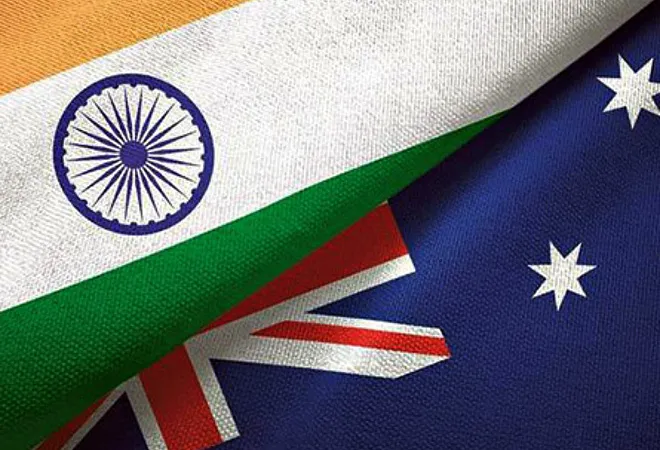
The signing of the Economic Cooperation and Trade Agreement (ECTA) by Australia and India on 2 April 2022 is yet another example exhibiting India’s recent euphoric spurt of getting into Free Trade Agreements (FTAs). This interim agreement also seems to be the harbinger of the Australia-India Comprehensive Economic Cooperation Agreement (CECA) that the two nations started negotiating way back in May 2011.
The ECTA is expected to reduce or even eliminate some of the barriers on trade goods and improve market access on specific items and sectors. This will take a more comprehensive form under the CECA that will cover most traded goods, diverse products, resources across sectors, and other areas such as services, investments, government procurement, and
intellectual property. With the ECTA in place, it is expected that the bilateral trade (merchandise and services) between India and Australia will almost double. This will happen due to extensive reductions in tariff and non-tariff barriers over the next decade, and also through promotion of trade in services through ease of movement of skilled labour and investments that can be further ameliorated once the CECA is in place. On the issue of market access, Australia has agreed to provide preferential market access on almost all of its tariff lines, including its labour-intensive sectors, thereby helping job creation.
The Food Sector: The Opportunities
In the agriculture and food sector (agri-food sector), India is keen on investments coming in from Australian companies in improving farming techniques with informed planting-choices, resource conservation, food technology and processing, and the dairy sector. The technology and investment collaborations aimed towards improving
grain management in India, with rationalisation of costs and logistics, will be crucial for the growth of this sector.
With the ECTA in place, it is expected that the bilateral trade (merchandise and services) between India and Australia will almost double.
Food from Australia can also pose significant competition to the Indian agricultural ecosystem. However, the opportunities lie in the threats only. Either the existing Indian system lives up to the competition by bringing in major revolution—right from the production processes to its marketing and procurement processes—or it will perish. Despite achieving self-sufficiency in food production, India has failed to transform its agriculture-food systems to keep pace with the emerging challenges, ensure efficiency in resource use, and be inclusive and sustainable at the same time. The competitiveness of the system is contingent upon creating modernised scientific farming systems, infrastructure development, and strengthening agriculture-food supply chains. This transformation is essential to meet two key policy goals: Doubling the income of farming communities and doubling India’s share of the global agri-food trade from
1 to 2 percent. Coupled with the two policy goals are the concerns regarding meeting the growing demand for food, pushed by increasing population, and more importantly, rising middle-income population that is demanding more value-added products i.e., from cereal to animal
protein-rich food and fresh food to premium products (high on nutrition with low chemical residues). India is evolving as a unique market place with a population of 1.4 billion demanding a range of products. Consequently, demand for grains, oilseeds, pulses, horticulture products, value-added dairy products, and premium meat is rising.
India is a significant market for Australia’s horticulture, wheat, and pulses. Nevertheless, there is a potential to grow even more for a range of cereal grains, pulses, oil seeds, and horticulture products. However, Australia-India trade in grains has
not developed to its potential largely because of tariffs, domestic price supports, subsidies on crop inputs, and other protectionist measures that India places on its imports. The interim FTA proposes to do away with most of these protectionist measures in due course of time and across a range of food products. Sheep meat, wool, lentils, horticulture, and wine are likely to experience
tariff reduction or elimination. The current five percent tariff on wool will be completely removed by the end of this year, while the 30 percent import tariff on sheep meat is likely to be slashed completely. Tariff on lentils will be reduced from 30 percent to 15 percent, while the tariff on faba beans will be cut to zero over the next seven years. Additionally, tariff on a range of horticulture products will also be cut to zero, whereas tariff on wine will reduce gradually.
Australia-India trade in grains has not developed to its potential largely because of tariffs, domestic price supports, subsidies on crop inputs, and other protectionist measures that India places on its imports.
Apart from tariff cuts and reduction in quotas, CECA will present prospects to cooperate on research, innovation, and scale that can
transform agriculture in India, especially in terms of value addition, commercial scale, and climate resilience. Australia has strong technological capacity and expertise in farming, post-harvest technologies, food processing, skills development, and creating resilient supply chains. These are also the goals that India wishes to achieve through the adoption of
Science, Technology, and Innovation (STI) to agri-food systems. Application of STI to agri-food systems is considered important from the perspective of achieving comprehensive nutritional and food security; extenuating the emergence of new infectious diseases and aggressive pests that often get transmitted along the entire agriculture-food system (about
30-35 percent of the annual crop yield in India gets wasted because of pests); mitigating the impacts of risks associated with climate change; creating climate smart agriculture; and moving from subsistence to commercial agriculture.
The market size presented by India—along with its commitment to technology-led revolution to agriculture—is an opportunity for Australia to build a long-term partnership in the latest agriculture technologies, infrastructure development, and providing premium food products to India’s middle- and upper-income populations. Australia is already helping India build knowledge around biosecurity treatment to avert such risks. It has a comprehensive biosecurity system in place that can adapt to rapidly evolving environments. The
National Grain Biosecurity Surveillance Strategy works towards early detection and surveillance related to market access in its grain industry. With the strengthening of economic ties, India can improve its capabilities in using biosecurity treatments for its exports and imports that will eventually enhance bilateral trade with Australia.
The Need for Value-Chain Reforms
The liberalisation of Indian agriculture has been talked about for decades. But even then, the sector has remained largely insulated, protected, and pampered with a host of sops. Any form of attempt to reform the sector with modern best practices has only faced vociferous opposition. What is crucial is that food shocks in India are still met through neo-Keynesian modes of thinking: Risk management responses from governments by disbursing the buffer stocks through the public distribution systems. During the pandemic, the government used various distribution mechanisms to provide food access to all. As such, high dependence on governmental systems never allowed for bringing in the organic efficiency in the agricultural marketing processes through the use of market-based instruments. One often fails to note that public procurement and building buffer stocks and buffer norms have failed in many parts of the world (e.g., Papua New Guinea), and do not conform to the norms of the global best practices in agricultural marketing, procurement, and distribution.
With the strengthening of economic ties, India can improve its capabilities in using biosecurity treatments for its exports and imports that will eventually enhance bilateral trade with Australia.
Back in 1996, United Nations Conference on Trade and Development published a report highlighting the importance of risk management for the agricultural value-chain in India, given the fact that Indian agricultural sector had to face the competition posed by a globalising world in view of the liberalising agricultural trade. In the process, the report emphasised the need for market-based risk management instruments and institutions. It was almost around the same time that the KN Kabra Chaired Committee recommended the resumption of futures trading in 16 agricultural commodities. In the new millennium, the prime objective for setting up demutualised multi-commodity derivatives exchanges was to provide a platform for hedging (risk management) and price discovery in agricultural commodities.
The question that looms large till now is: Despite two decades of their operations in India, have the commodity derivatives exchanges been able to play that role? The answer seems largely in the negative. Neither these markets have been able to substitute the fragmented agricultural physical markets, nor have they been able to render efficiency to the processes of agricultural marketing especially in food commodities. Even recent interventions like the pan-India electronic spot markets (i.e., E-Nam) has failed to emerge as a platform for market integration due to the fragmented nature of the agricultural markets in India, and the extensive digital divide. However, foreign competition in the food sector would warrant bringing in efficiency in the value-chain. Otherwise, the existing Indian value-chain will not be able to survive the competition posed by the Australian food sector in the level playing ground that will be ushered by the CECA. Under those circumstances, all we can expect are food imports from Australia negatively affecting the players in the existing food value-chain in India, and not Australian investments in the food sector. Both these will be inimical for “Make in India” and/or “Aatmanirbhar Bharat”.
The views expressed above belong to the author(s). ORF research and analyses now available on Telegram! Click here to access our curated content — blogs, longforms and interviews.



 The signing of the Economic Cooperation and Trade Agreement (ECTA) by Australia and India on 2 April 2022 is yet another example exhibiting India’s recent euphoric spurt of getting into Free Trade Agreements (FTAs). This interim agreement also seems to be the harbinger of the Australia-India Comprehensive Economic Cooperation Agreement (CECA) that the two nations started negotiating way back in May 2011.
The ECTA is expected to reduce or even eliminate some of the barriers on trade goods and improve market access on specific items and sectors. This will take a more comprehensive form under the CECA that will cover most traded goods, diverse products, resources across sectors, and other areas such as services, investments, government procurement, and
The signing of the Economic Cooperation and Trade Agreement (ECTA) by Australia and India on 2 April 2022 is yet another example exhibiting India’s recent euphoric spurt of getting into Free Trade Agreements (FTAs). This interim agreement also seems to be the harbinger of the Australia-India Comprehensive Economic Cooperation Agreement (CECA) that the two nations started negotiating way back in May 2011.
The ECTA is expected to reduce or even eliminate some of the barriers on trade goods and improve market access on specific items and sectors. This will take a more comprehensive form under the CECA that will cover most traded goods, diverse products, resources across sectors, and other areas such as services, investments, government procurement, and  PREV
PREV



